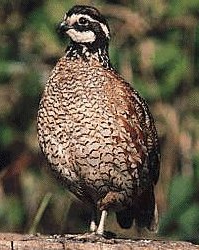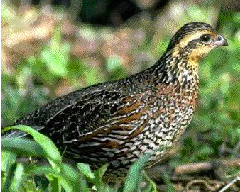The popular Bobwhite Quail is a favorite of game bird breeders, hunters and bird lovers alike. Just about everyone is familiar with male’s call for which the species is named. These plump little birds have the most widespread range of any quail species, with over 20 subspecies ranging from Canada to southern Mexico. They have also been introduced abroad, to such places as Hawaii and New Zealand, as a game species. Commercial game bird farms raise thousands each year for release in the US and Canada.
Of the subspecies, the Eastern Bobwhite (C. v. viriginaus), is the most often kept and seen. They are found in a variety of habitats, from open woodlands & fields to suburban parks. Those with bird feeders in their yards are sometimes greeted a few quail who come to feed on the seed that is dropped by the other birds. Males have a white throat and eye-line, with a dark crown and a black line that separates the white on the throat to the eye-line. The lower breast is mottled white & dark brown; sides have light brown streaks and the back and rest of the body mottled brown overall; tail gray. The hens are similar, but her throat and eye-line is buff and her overall color is somewhat lighter. They form large groups during the winter called coveys. These coveys can consist of up to 30 or more birds and when disturbed, all will burst into flight at once.
A rarer subspecies, the Masked Bobwhite (C. v. ridgwayi), is native to the Southwest. They are popular with breeders in captivity, but remain on the Endangered Species List in the wild. These birds are similar to the eastern race, but males have a very dark face & throat. They also appear darker overall.
The further south you travel into Mexico, the Bobwhite subspecies differ a great deal from the northern counterparts. Many have much more white on the throats and a more detailed barring on the breast. It is a shame that some of these races have yet make their way to our aviaries, as they are beautiful birds. Perhaps in the future, some may make their way and become established in captivity.
Breeding
 Bobwhites present no problems in captive rearing, and can be produced easily in modest surroundings or large aviaries. Many producers house their breeders in breeding batteries, some as small as 1′x1′x1′ and keep them in trios or pairs. These batteries are designed to allow the keeper to feed, water and gather eggs (sloped flooring) without entering the cage. We have had success keeping our quail in larger wire bottom cages, usually about 2′x3′x2′ with roosts and material for nesting. We also kept a pair in large flight aviary with other birds one year and they did very well. You can choose to colony mate (several hens with two or three males), trios (one male with two hens) or in pairs.
Bobwhites present no problems in captive rearing, and can be produced easily in modest surroundings or large aviaries. Many producers house their breeders in breeding batteries, some as small as 1′x1′x1′ and keep them in trios or pairs. These batteries are designed to allow the keeper to feed, water and gather eggs (sloped flooring) without entering the cage. We have had success keeping our quail in larger wire bottom cages, usually about 2′x3′x2′ with roosts and material for nesting. We also kept a pair in large flight aviary with other birds one year and they did very well. You can choose to colony mate (several hens with two or three males), trios (one male with two hens) or in pairs.
Bobwhite hens begin laying in mid April and may lay all summer long. The eggs are pure white and are incubated for 21 days. You will probably have to use artificial incubation with this species, as many captive hens are mass producers of eggs are highly unlikely to go broody in a cage setting. Bobwhites are also induced into laying earlier than normal using artificial light. Some larger farms also use the lights to have hens produce eggs year round.
Chicks are easy to raise in the brooder. They require a high protein diet and lots of room, as they are very active and prone to picking if overcrowded. The chicks are kept in a brooder setting for about six weeks, then they are moved to covered, outdoor enclosure.
General Comments
 As mentioned, Bobwhites are easy to keep and raise. They are often one of the first species of quail for the beginning quail breeder and many long-time breeders keep them around for the male’s call. Like many other species of quail, they seem to do best on wire, but can be kept on the ground if the aviary is well-drained.
As mentioned, Bobwhites are easy to keep and raise. They are often one of the first species of quail for the beginning quail breeder and many long-time breeders keep them around for the male’s call. Like many other species of quail, they seem to do best on wire, but can be kept on the ground if the aviary is well-drained.
During the Winter, birds that are not kept indoors such as a barn, should be grouped together so they can form natural coveys for warmth. I also recommend keeping dry straw or hay in the cage during the Winter.
Bobwhite should be fed a good quality game bird ration of at least 16% protein during the non-breeding season to 20% during the laying period. I also supplement their diet with various grains, greens and mealworms.
Mutations
There have been a number of mutations developed in captivity. Some of the popular colors include the Mexican Speckled, the Tennessee Red, White and Silver Bobwhites. There are also strains developed for their large size, such as the Wisconsin Jumbo and the Indiana Giant. I will add a more complete description of the mutations and perhaps another page for them at a later date. Care and breeding of the various mutations is the same as the normal Bobwhite.


